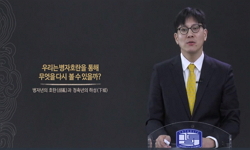King Yeongjo is generally known to have concentrated upon the so-called Wanron-Tangpyeong/緩論蕩平 policy based upon the concept of Jojae Bohab/ 調劑保合, Yet that principle was not applied to every situations at every times during the entiret...
http://chineseinput.net/에서 pinyin(병음)방식으로 중국어를 변환할 수 있습니다.
변환된 중국어를 복사하여 사용하시면 됩니다.
- 中文 을 입력하시려면 zhongwen을 입력하시고 space를누르시면됩니다.
- 北京 을 입력하시려면 beijing을 입력하시고 space를 누르시면 됩니다.
https://www.riss.kr/link?id=A45007650
-
저자
이경구 (한림대학교 한림과학원 한국학연구소)
- 발행기관
- 학술지명
- 권호사항
-
발행연도
2004
-
작성언어
Korean
-
주제어
영조 ; 탕평론 ; 의리 ; 국왕권 ; Yeongjo ; Tangpyeongnon ; Loyalty ; Royal prerogative
-
KDC
900
-
등재정보
KCI등재
-
자료형태
학술저널
- 발행기관 URL
-
수록면
23-44(22쪽)
-
KCI 피인용횟수
20
- 제공처
- 소장기관
-
0
상세조회 -
0
다운로드
부가정보
다국어 초록 (Multilingual Abstract)
For that task, King Yeongjo prepared relevant ideologies and also a new political structure. In essence, he argued the public nature of the Euiri concept, and intended to place it under the King's own authority. This pushed(or forced) the Euiri concepts which were previously upheld by the Scholar- officials, who employed devices like the so-called Samun Shibi/斯文是非, into the realm of ptivate discussions, and led to the eventual weakening of the scholar-officials' position inside the government, Such scholar-officials were replaced by the Saeshin/世臣 officials and the general public as the King's political partner, and also the government's aim in general policies.
King Yeongjo's handling of the political arena', which he showed during the latter half period of his reign, reminds us of the actions of the 15th century Chosun kings, and especially King Saejong. But there is also a definitive difference, King Yeongjo was aiming for a political model which was very similar to that of the dynasty's early years, but the political model he was aiming for was also based on a society functioning upon the activities and authorities of the scholar-officials. In essence, he was trying to establish a new model, merging this two distinct kinds of form together. His goal was to sublate the models inherited by the 15th, 16th and 17th centuries, and the result was the Tangpyeong policy which was indeed the terminal state of politics that the Chosun Confucian politics could ever reach.
King Yeongjo is generally known to have concentrated upon the so-called Wanron-Tangpyeong/緩論蕩平 policy based upon the concept of Jojae Bohab/ 調劑保合, Yet that principle was not applied to every situations at every times during the entirety of King Yeongjo's reign. During the latter half period of his reign, King Yeongjo denied the Euiri/의리 concept, at least the version suggested and strongly supported by party politics, and instead reinforced the leadership and authority of the king.
For that task, King Yeongjo prepared relevant ideologies and also a new political structure. In essence, he argued the public nature of the Euiri concept, and intended to place it under the King's own authority. This pushed(or forced) the Euiri concepts which were previously upheld by the Scholar- officials, who employed devices like the so-called Samun Shibi/斯文是非, into the realm of ptivate discussions, and led to the eventual weakening of the scholar-officials' position inside the government, Such scholar-officials were replaced by the Saeshin/世臣 officials and the general public as the King's political partner, and also the government's aim in general policies.
King Yeongjo's handling of the political arena', which he showed during the latter half period of his reign, reminds us of the actions of the 15th century Chosun kings, and especially King Saejong. But there is also a definitive difference, King Yeongjo was aiming for a political model which was very similar to that of the dynasty's early years, but the political model he was aiming for was also based on a society functioning upon the activities and authorities of the scholar-officials. In essence, he was trying to establish a new model, merging this two distinct kinds of form together. His goal was to sublate the models inherited by the 15th, 16th and 17th centuries, and the result was the Tangpyeong policy which was indeed the terminal state of politics that the Chosun Confucian politics could ever reach.
목차 (Table of Contents)
- 머리말
- 1. 군주권의 위상 강화
- 1) 왕위 계승의 정통성 강조
- 2) 사대부 의리의 부정과 군부일체론(君父一體論)
- 2. 세신(世臣)ㆍ민에 대한 강조와 국가 제도의 정비
- 머리말
- 1. 군주권의 위상 강화
- 1) 왕위 계승의 정통성 강조
- 2) 사대부 의리의 부정과 군부일체론(君父一體論)
- 2. 세신(世臣)ㆍ민에 대한 강조와 국가 제도의 정비
- 1) 세신과의 협력과 위민의 강조
- 2) 기강 수립과 국가 제도 정비
- 맺음말
동일학술지(권/호) 다른 논문
-
- 한국역사연구회
- 안병우
- 2004
- KCI등재
-
- 한국역사연구회
- 이경구
- 2004
- KCI등재
-
- 한국역사연구회
- 최성환
- 2004
- KCI등재
-
- 한국역사연구회
- 김창석
- 2004
- KCI등재
분석정보
인용정보 인용지수 설명보기
학술지 이력
| 연월일 | 이력구분 | 이력상세 | 등재구분 |
|---|---|---|---|
| 2026 | 평가예정 | 재인증평가 신청대상 (재인증) | |
| 2020-01-01 | 평가 | 등재학술지 유지 (재인증) |  |
| 2017-01-01 | 평가 | 등재학술지 유지 (계속평가) |  |
| 2013-01-01 | 평가 | 등재학술지 유지 (등재유지) |  |
| 2010-01-01 | 평가 | 등재학술지 유지 (등재유지) |  |
| 2008-01-01 | 평가 | 등재학술지 유지 (등재유지) |  |
| 2006-01-01 | 평가 | 등재학술지 유지 (등재유지) |  |
| 2005-10-05 | 학술지명변경 | 한글명 : 역사와 현실 -> 역사와 현실외국어명 : 미등록 -> YŎKSA WA HYŎNSIL |  |
| 2004-01-01 | 평가 | 등재학술지 유지 (등재유지) |  |
| 2001-01-01 | 평가 | 등재학술지 선정 (등재후보2차) |  |
| 1998-07-01 | 평가 | 등재후보학술지 선정 (신규평가) |  |
학술지 인용정보
| 기준연도 | WOS-KCI 통합IF(2년) | KCIF(2년) | KCIF(3년) |
|---|---|---|---|
| 2016 | 0.91 | 0.91 | 0.87 |
| KCIF(4년) | KCIF(5년) | 중심성지수(3년) | 즉시성지수 |
| 0.87 | 0.92 | 1.68 | 0.36 |




 DBpia
DBpia




